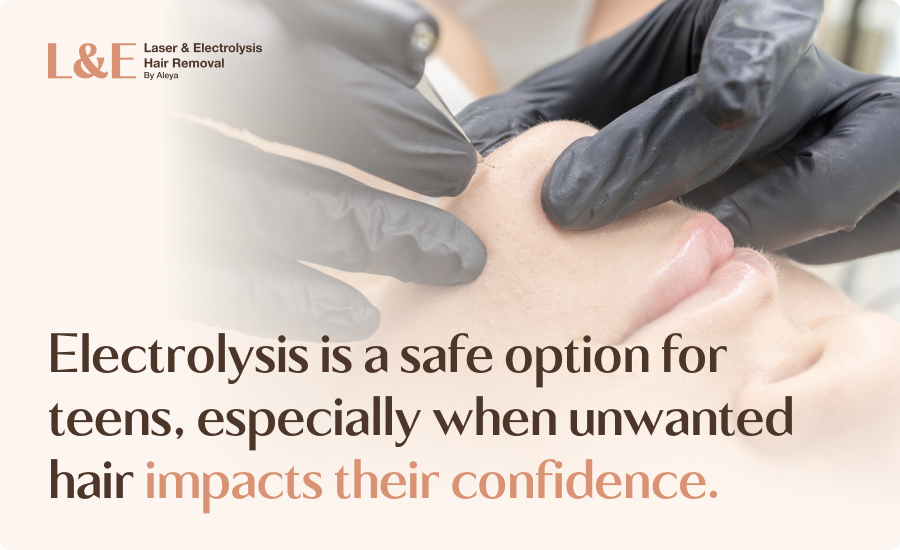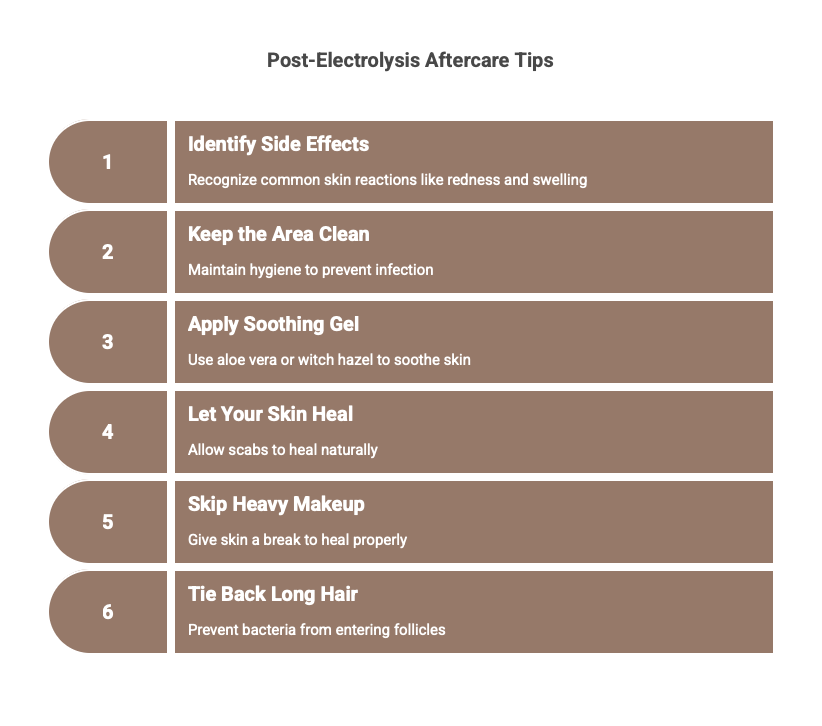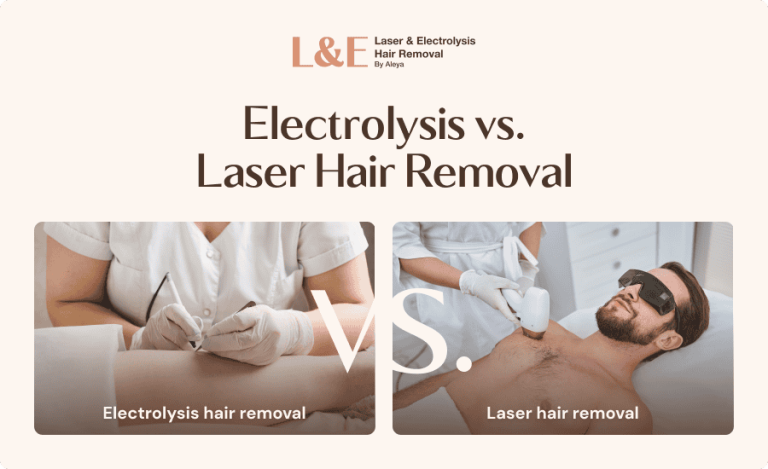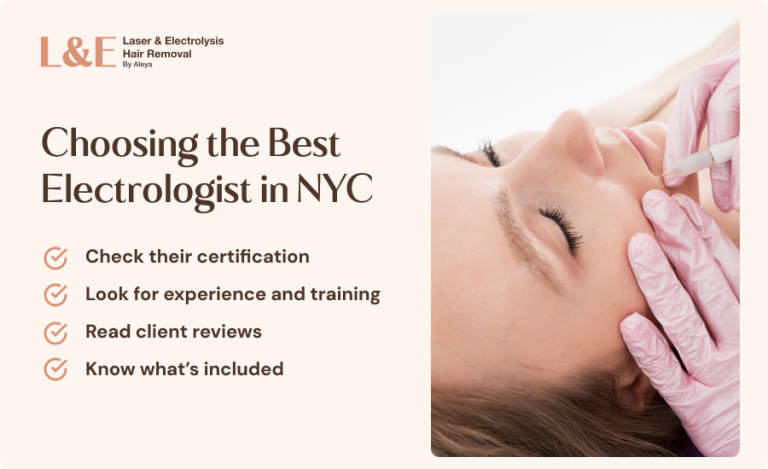How Old Do You Have To Be To Do Electrolysis? [+ FAQs]
![How Old Do You Have To Be To Do Electrolysis? [+ FAQs]](https://www.laserbyaleya.com/wp-content/uploads/2025/05/how-old-do-you-have-to-be-to-do-electrolysis-hero-image-new.png)
How Old Do You Have To Be To Do Electrolysis? Key Takeaways
- Teens can start electrolysis when they turn 14
- Younger clients often start treatment with facial areas like the upper lip
- Electrolysis is usually safe for teens, including those with sensitive or acne-prone skin
Once you’ve hit puberty and hair has started growing on your face or body, it’s generally safe to start electrolysis.
Around this age, the body is maturing, the skin is less sensitive, and it retains more natural moisture, making treatments easier and more comfortable.
If you’re considering electrolysis at a younger age or for a teen, this guide breaks down everything you need to know.
We will:
- Discuss what areas can be safely treated at a young age
- Explore how electrolysis works and whether it’s painful
- Cover how to prepare for your session, plus essential aftercare tips
- Answer pressing FAQs surrounding how old do you have to be to do electrolysis
What Areas Can Be Treated at a Young Age?
Electrolysis can be a safe and effective option for teens dealing with unwanted hair, especially when it affects their confidence or emotional well-being.
But because the body is still developing, certain areas might not respond as well to treatment during puberty.
Common treatment areas for younger clients often include:
- The upper lip for visible facial hair that may cause embarrassment.
- The chin, particularly when early hormonal changes lead to noticeable growth.
- Eyebrows to shape or clean up excess hair in a precise, long-lasting way.
- Sideburns for aesthetic refinement or managing thicker facial hair.
Teens typically choose these areas because they are small, visible, and often a cause of concern.
They also tend to respond well to electrolysis and require fewer sessions than larger body areas.

How Does Electrolysis Work?
A certified electrologist carefully inserts a fine probe into the hair follicle beneath the skin’s surface.
A small electric current is then delivered to the base of the follicle, targeting and destroying the hair root.
This permanently stops future growth and causes the current hair to shed.
According to the American Academy of Dermatology Association, only licensed electrologists or aestheticians working under the direct supervision of a board-certified dermatologist should perform electrolysis.
Is Electrolysis Painful?
No, electrolysis isn’t painful but some people find it slightly uncomfortable.
The sensation is often compared to a quick zap, a light pinch, or a tiny rubber band snap.
How it feels can vary based on your personal pain tolerance and the area being treated.
Below is a comparison table showing how electrolysis and other common hair removal methods stack up in terms of pain level and sensation:
| Method | Pain Level | Sensation Description |
| Electrolysis | Mild to moderate | Light pinch or tiny rubber band snap |
| Laser hair removal | Mild | Warm sting or rubber band snap |
| Waxing | Moderate to high | Sharp pull or sting |
| Shaving | Minimal | Usually painless, occasional nicks or irritation |
| Depilatory creams | Minimal to mild | Tingling sensation |
How To Prepare for Your First Electrolysis Session
Getting ready for your first electrolysis appointment can feel a little intimidating but knowing what to expect can help calm any nerves.
1. Start With a Consultation
Your first electrolysis session usually starts with a consultation.
Your electrologist will assess the area you want to treat, explain how the process works, and set realistic expectations.
You’ll also go over the number of sessions needed, pricing, and the equipment used.
This is your chance to ask questions and make sure you feel comfortable moving forward.
2. Share Key Details About Your Skin and Health
To get the best results, be open about your skin type and medical history.
Electrolysis works on all skin tones and hair types, but your individual characteristics can affect how your skin responds.
Let your electrologist know about any sensitivities, allergies, medications, or conditions like polycystic ovary syndrome (PCOS) that can impact hair growth.

3. Prep To Minimize Discomfort and Anxiety
Stay well-hydrated in the days leading up to your session, and try to avoid caffeine a few hours beforehand, as it can make you feel more anxious and sensitive to pain.
If your electrologist suggests it, you can also apply a numbing cream before your appointment.
Getting a good night’s sleep and showing up a little early can help you feel more relaxed and ready.

What To Expect and Aftercare Tips Following Your Electrolysis Session
The first 48 hours after electrolysis are super important for helping your skin heal and avoiding any irritation or infection.
Here are common electrolysis hair removal side effects and a few ways to take care of the treated area.
- Redness, swelling, or tenderness in the treated area which usually fades within 48 hours
- A warm or flushed feeling in the skin that can linger for a day or two
- Tiny scabs or crusting (also called “pin dot” scabbing) might form as your skin heals
- Mild itching as part of the natural healing process
Post-electrolysis? Here’s how to care for your skin like a pro.
1. Keep the Area Clean and Dry
Avoid touching, rubbing, or scratching so your follicles have the chance to close and heal properly.
2. Apply Soothing Gel
Apply aloe vera or witch hazel gel using clean cotton or freshly washed hands to soothe the skin and reduce redness.
Keep using aloe as needed over the next couple of weeks to help your skin heal.
3. Don’t Pick at Your Skin
If you notice small scabs, let them fall off on their own. Picking can delay healing and increase the risk of infection or scarring.
4. Don’t Apply Heavy Makeup
Give your skin a little breather and skip the heavy makeup for 24 to 48 hours.
Doing so helps your skin heal properly and lowers the risk of irritation or infection.
5. Tie Back Long Hair
If you’ve had facial electrolysis and have long hair, keeping it pulled back can help prevent bacteria from getting into open follicles.

Find Expert Electrolysis Hair Removal Services in Great Neck, NY
Ready to stop the endless cycle of shaving and plucking?
Laser by Aleya offers expert electrolysis hair removal in Great Neck, NY, trusted by both teens and adults.
Whether you’re just starting your journey or maintaining your long-lasting results, Aleya provides gentle, personalized care in a comfortable setting.
How Old Do You Have To Be To Do Electrolysis? FAQs
Is electrolysis safe for teens with acne?
Yes, electrolysis is generally safe for teens, even those with acne-prone skin.
However, if the area is inflamed, broken, or has active cystic breakouts, it’s best to wait or treat a different spot until the skin improves.
Can electrolysis cause scarring?
No, electrolysis doesn’t cause scarring when performed by a skilled professional.
It’s a safe procedure with only mild, temporary side effects like redness or slight swelling, which usually fade on their own.
How many sessions are needed?
The number of electrolysis sessions needed for permanent hair removal varies from person to person, but most people need around eight to 12 sessions.
The entire process can take anywhere from eight months to two years or more, depending on factors like the area being treated, your hair type, and your hair growth cycle.
How old do you have to be to get laser hair removal?
Younger clients are typically advised to wait until they’re 18 for laser hair removal, since developing hormones and hair follicles can affect how effective and long-lasting the results are.

![Can You Perform Electrolysis on a Mole With Hair? [+ FAQs]](https://www.laserbyaleya.com/wp-content/uploads/2025/09/mole-with-hair-hero-image-768x469.png)
